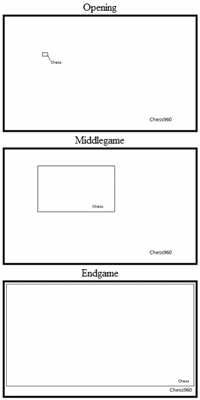Let's try filling in the blanks: 'Chess is to chess960 as ... is to ...'
Following the modern trend of reducing all communication to the bare minimum, I'll abbreviate that to CHESSIS2C960.

The image on the left compares chess to chess960 for the three major phases of the game. If squinting doesn't help, just know that the large boxes are labelled 'chess960', and the small, progressively larger boxes are labelled 'chess'.
In the opening, chess has somewhat more than 1/1000th the complexity of chess960. In the middlegame, I've shown it at about 1/7th the complexity. In the endgame they have nearly identical complexity. There are a few legal chess960 endgame positions that can't occur in chess, but they aren't worth worrying about (*).
As for the middlegame complexity, we don't know what the relative values are. There are many positions arising from chess960 that could arise only with great difficulty from the traditional start position. There are many never-before-seen strategies in chess960, but how could we quantify them? How would we even start to enumerate them?
Perhaps we should start by identifying some of the new strategies and hope that some pattern emerges. That's about as much as I can do with this blog.
(*) Certain problems/studies that are illegal in chess might be legal in chess960, but I can't give any specific examples.

No comments:
Post a Comment